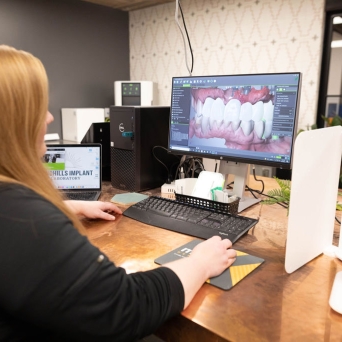Digitization is now happening all throughout dentistry! We caught up with Sara Bargen, Managing Director and Lead Tech of Sandhills Implant lab, to discuss how she uses a digital workflow in fabricating modern implant restorations today. Let’s get the down-low on her work-flow. (And if you don’t know, now you know.)
Sara might be new to Kearney, but she certainly isn’t new to the world of digital dentistry. In her 13 years of dental arts experience, she has seen digital technology persistently work to find its place in restorative treatment planning. Thankfully, that persistence did pay off— for technicians, physicians, and most importantly our patients.
Digital equipment, software and materials have reached a level of sophistication that is revolutionizing the industry. “A digital workflow now allows us to create state-of-the-art restorative solutions that give patients life-changing results and a better quality of life,” says Sara. At Sandhills Implant Laboratory, she integrates a digital workflow with traditional methods to provide efficient, accurate and precise results for patients.
One of the goals for Sandhills Implant Laboratory and Sandhills Oral & Facial Surgery is to provide immediate temporization with esthetic and functional success. “From first scan to final smile, our CAD/CAM software and intraoral scanner allow us to do just that!” Sara sees many benefits in using a digital workflow for a more collaborative and streamlined process.
Efficiency
Previously, the only option for impressions was a conventional, mold-making process that takes several weeks before the prosthetic fabrication process can begin. With intraoral digital scanning, we can take digital impressions immediately and share them directly to all members of the restorative team. “This allows me to begin fabricating single unit or small span bridge restorations as soon as a digital scan is taken. Then I can seat it later that day” - Sara.
Accuracy
A recent study took 302 conventional impressions and found that 80% of those had insufficient or inaccurate information! It is exciting to see how much digital scans increase the level of accuracy. At Sandhills, a digital scanning service is provided at the patient’s integration check. This eliminates the need for traditional impressions and significantly improves the accuracy of implant restorations. We have seen far less chair time for patients as well.
It is extremely beneficial to have access to technology proven to eliminate human error. “Instead of wasting time and energy on pouring models, I can focus my time and energy on customizing restorations for contour, shade and esthetic detail,” Sara adds. When inaccurate impressions are taken, it can snowball into other issues, such as wasted chair time, extra costs, and valuable time lost for everyone.
Sara has brought some of the most exciting innovations in dental implant technology to our greater Nebraska community! This is excellent news for patients and dental professionals alike. Sara has been globally recognized for her excellence in digital dentistry and “dedication to dental clinicians and patients,” as the 2021 Smart Integration Award Winner.

